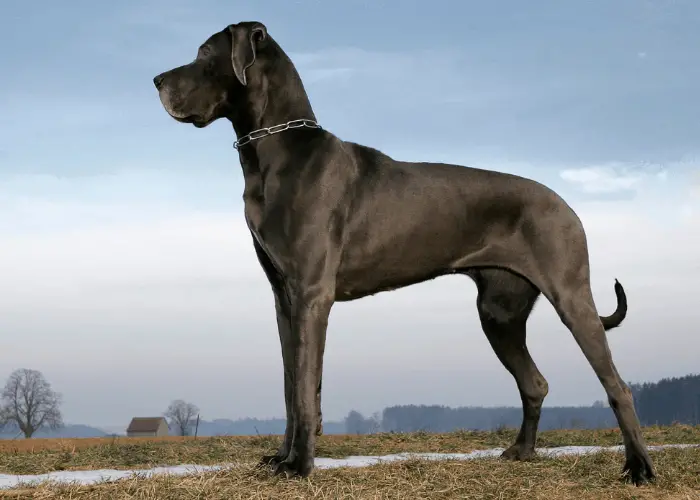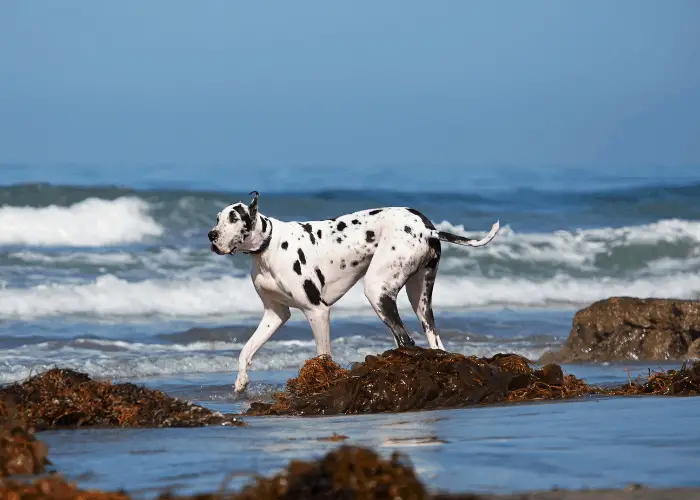The Great Dane is a German dog breed, with beginnings dating all the way back to 3,000 B.C.E as seen on ancient Egyptian monuments. Originally, the Germans used Great Danes as hounds to hunt Boar and for protection.
During the 16th century, when hunting was not a necessary priority for the German breed, they began to become domesticated. In that period, the breed was only common among the wealthy and the upper class, as they were a symbol of high status. The breed’s name was changed over time, starting with the
German name Kammerhunde, or Chamber Dog. Contrary to popular belief, Denmark was never involved in breeding the dog, and only contributed the name. Great Dane, the name that stuck, was thought up by a Danish man with the name of Buffon.
Great Danes are famous for their tall stature, commonly reaching heights well over 70 cm and weights over 45 kg. In addition to their height, they are known to be quick tempered and vindictive in certain situations. Great Danes are relatively painless to train and, with time, can easily become formidable guard dogs.
Furthermore, they are known to be very social towards adults and children alike. Their vibrant playfulness is coupled by their entertaining personalities. Great Danes are generally calm, quiet, and tend not to bark too often. The average life expectancy of a Great Dane is between eight and ten years.
Body Type

In addition to Great Danes being classified as a Giant Breed, male Great Danes normally have a greater size than their female counterparts. To be specific, female Great Danes have an average size of 71-76 centimeters at the shoulders, while males average around 76-83 centimeters.
As long as the dog is proportional and well-coordinated, a greater size is generally better. Ideally, male Great Danes should not be below the standard limit of 76 centimeters, and 71 for females Danes. Dogs below those limits will, unfortunately, not quality for races.
Similar to their heights, Great Danes come in a wide variety of weights. Even though they average between 60-80 kg, they have been known to reach weights of up to 90kg in a male! Coat: Great Danes have short, smooth and thick fur that is fairly easy to groom.
In addition, their coats have a spectacular and glossy appearance which comes in a wide variety of colors. Danes shed moderately in comparison to other dog breeds.
Color

Great Danes are bred in six distinct, approved coat colors. These coat colors consist of Brindle, Fawn, Blue, Black, Harlequin and Mantle. Brindle Great Danes have a faun base, with a black chevron stripe pattern resembling that of a tiger. Fawn Danes are yellow gold with a black mask typically covering the eye rims, eyebrows and/or the ears.
Blue Danes have a pure blue color. White markings on a blue Dane are generally undesired and are considered a genetic fault. Black Great Danes feature a glossy black color all over the body. Similar to that of a blue Dane, white markings on a black Dane are considered genetic faults.
Note that the aforementioned white marks typically reside on the chest and toes of the Dane. Harlequin Great Danes have a white base color. In addition, they feature irregularly distributed black torn patches across the body.
Although the black patches vary in size, they shouldn’t be too small to give a stipple visual effect. On the contrary, they shouldn’t be too large as to give a blanket-like appearance. The final approved color is mantle, which is characterized by a white and black body, with a black blanket extending over the Dane.
Furthermore, Danes of this coat color feature a white muzzle and a black skull. Since this color is similar to that of a Boston Terrier, is it often referred to as Bostons instead of mantle. Unlike black and blue Danes, it is considered acceptable for a mantle Dane to have a small white marking in the blanket.
Although the previously mentioned six colors are the official Dane colors, several other colors have been bred. These colors include, but are not limited to, merle, white, fawnequin, merlequin, brindlequin, fawn mantle, blue mantle and more.
Since these colors aren’t acceptable, Great Danes of these colors typically cannot compete in shows. Breeding of white and merle Danes is actively discouraged because they include genes that occasionally cause deafness.
Temperament

Despite the great size of Great Danes, they are by nature very friendly and dependable. They carry this friendliness to other dogs, other pets that aren’t of the canine family, and to humans. They’re a very gentle breed and generally never convey too much aggression or timidness.
With proper training, the well-spirited breed will always be great around children. However, note that it is not uncommon for Great Danes to be somewhat resistant towards new or unfamiliar environments and towards strangers. As a result, Great Danes are most suited toward families, especially if the family starts to get the dog trained early on in his or her life.
Tasty Tidbits

Even though Great Danes have a short coating, they still need to be frequently groomed and taken care of. In most months when the dog spends a significant amount of time indoors, it should be properly bathed once a month.
However, in the summer, the frequency should be raised to at least twice a month. When bathing the dog, be sure to note any allergies it has or if it has sensitive skin, as some shampoos may cause reactions. After shampooing, follow it up with a conditioner to keep the coat healthy.
Since the breed sheds its coat throughout the year, it will need to be properly groomed every 4-8 weeks. During the periodical grooming session, be sure to check and clean the ears with an approved product. In addition, check the eyes, clip the nails, and check the dog’s anal glands.
RELATED ARTICLE: Great Dane Cropped Ears: Styles, Cost, and Care
In addition, be sure to use an approved shedding blade on the coat to remove the dead coat. Never neglect foot and paw care, which is as simple as a frequent massage and a note of any injuries or discomforts. Neglecting foot and paw care can lead to postural issues.
Check Out the List Of Famous Great Danes Below:

